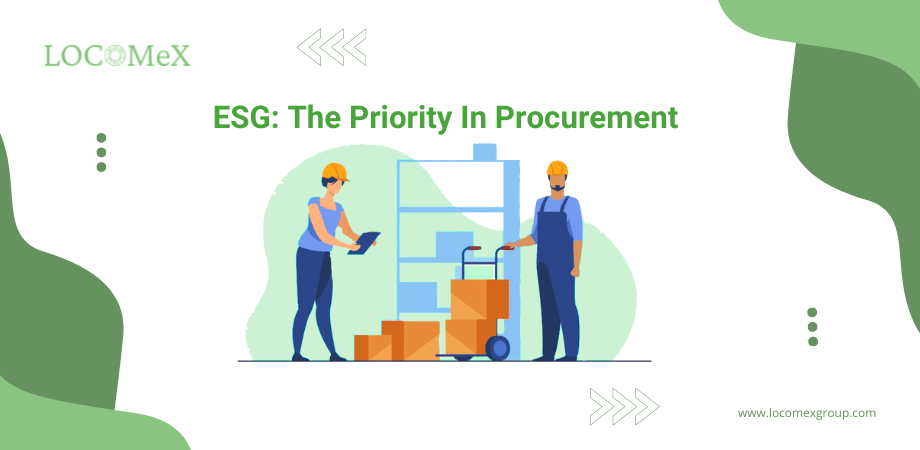Once a support role, procurement is increasingly moving to the forefront of sustainability strategy. It’s so important that according to a recent Accenture analysis, half of the surveyed company leaders view procurement as a top method of achieving ESG goals.
The survey also discovered that 90% of an organization’s sustainability risks originate from its suppliers. This result means executives who rethink their procurement strategy and focus on sustainability today will find great potential to spur change and advance their progress in the future. So, when creating procurement strategies, ESG must be the top priority and primary consideration
Although the concept of sustainable purchasing practices may appear simple, applying sustainability in the supply chain can be challenging because there are many factors to consider.
An end-to-end supply chain procurement platform powered by AI is the best ESG benchmarking tool available on LOCOMeX. It is simple to use, promotes innovation and collaboration, and benefits all stakeholders equally.
What Is Sustainable Procurement?
Sustainable procurement integrates Environmental, Social, and Governance (ESG) concepts into procurement procedures and policies, ensuring that a business with suppliers is handled in a manner that complies with corporate social responsibility (CSR) initiatives.
The four major goals of sustainable procurement are as follows:- Reduce the negative effects of products or services over their entire life cycle and supply chain.
- Reduce the need for nonrenewable resources.
- Ensure that reasonable contract prices and conditions are observed and followed.
- Encourage diversity and equality across the whole supply chain.
Importance Of Sustainable Procurement
Staying true to the goals of sustainability initiatives is crucial if one wants to foster repeat business, form relationships with key suppliers, and increase stakeholder expectations. The following are some advantages of sustainable procurement:
- Financial: Utilizing sustainable procurement allows for more cost-effective purchasing practices of goods and services, lowers the overall operating costs, and boosts operational profitability.
- Reduce risk: Companies can identify the challenges and opportunities to economic, legal, environmental, and social sustainability by implementing sustainable procurement practices. Additionally, the companies can develop strategies for managing them.
- Decreased cost: The total cost of ownership will decrease if sustainable buying methods and choices are used. This result is accomplished through lower energy costs, lower over-specification, lower consumption, and lower expenses associated with social and environmental compliance.
- Revenue growth: A procurement organization might generate more income by developing eco-friendly goods and services, charging a premium, or receiving money from recycling programs if they use sustainable practices.
- Future-proofing: One strategy for future-proofing the organization against a potential supply constraint is to create procurement strategies that will aid in defending against alterations in economic elements like fluctuating currency rates, social factors like the accessibility of technology, human rights, due diligence, and environmental influences like climate change.

How Can Procurement Boost the Effectiveness of ESG Programs?
To accomplish ESG goals and a sustainable future, the procurement teams must know how suppliers affect sustainability throughout the supply chain and how the procurement function must develop to shape an organization’s ESG criteria. So, for each of these areas to improve and enhance ESG initiatives, businesses should reassess sourcing by taking the following actions.
An increasingly important first step is changing your procurement perspective to concentrate on local communities or suppliers because these vendors are often more agile and quicker in introducing innovative ideas to emerging issues.
Hence, opening up your options to more diverse suppliers, especially local ones in your supplier base, can help businesses become more innovative and agile. It can also aid in reducing its carbon footprint and increase its influence on corporate social responsibility.
So, when looking for new suppliers from an ESG standpoint, identify hotspots in the value and supply chain and companies who share information about how they prioritize lowering their environmental impact.
With the help of the best ESG benchmarking tool from LOCOMeX, you can manage your ESG metrics, supplier diversity, and local content compliance programs in one location.
Data is essential for assessing suppliers and proving your Return on Investment (ROI) to important stakeholders. Seek more suppliers who track and disclose their sustainability goals so you can decide which will best contribute to your unique ESG initiatives and progress.
Once you have made data-informed decisions about your supplier network, the next stage is deciding what data you need to collect and analyze to represent your organization’s overall ESG impact. Because your upstream and downstream supply chains are included in scope 3 emissions and social hazards, procurement leaders must incorporate supplier sustainability data into their data collection approach to obtain an accurate picture and audit trail.
Enable tools like cloud computing, AI, and predictive analytics to implement a successful data collection plan so that you can have all the evidence at your fingertips to demonstrate the return on investment in diverse suppliers and sustain stakeholder support.
Create in-depth, department-specific training that outlines the company’s strategy for achieving ESG goals and the precise contributions that each employee will make to the effort.However, some companies might be just beginning their ESG agenda and need to be more conversant with their objectives. And to enhance their ESG performance, they may need further assistance. So, procurement professionals must be ready to collaborate closely with such vendors and follow these strategies to build sustainability:
- Conduct seminars and training sessions on ESG objectives, including supply chain decarbonization and ethical labor practices.
- Offer free audits and professional advice on subjects like energy and carbon emissions.
- Create policies that reward cooperation and promote transparency regarding ESG results.
- Establish long-lasting connections with suppliers and remove any obstacles to ESG advancement.
How Can LOCOMeX Help?
The project-based ESG risk scoring tool from LOCOMeX provides the most thorough analysis of Scope 3 emissions. LOCOMeX’s best ESG benchmarking tool is modified to improve and meet your supplier diversity and local content compliance goals by utilizing the predictive intelligence derived from AI-powered data-driven solutions. Reach out to our experts now to explore more about our enterprise ESG software.



